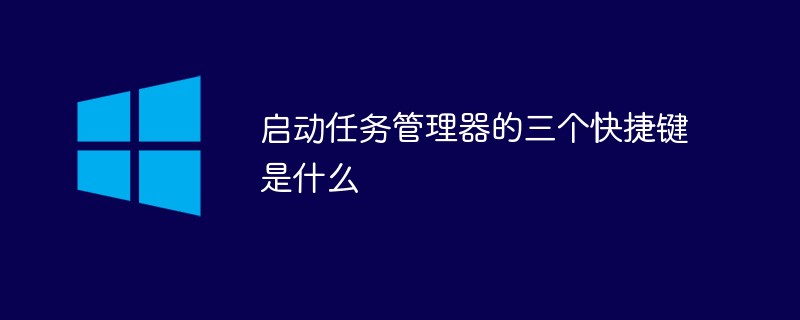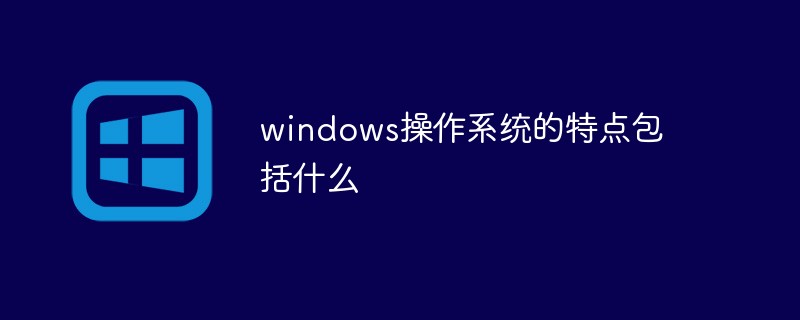 Operation and Maintenance
Operation and Maintenance Windows Operation and Maintenance
Windows Operation and Maintenance What is the desktop in windows system?
What is the desktop in windows system?The desktop refers to the main screen area of the monitor you see after turning on the computer and logging in to the system. The desktop is the surface on which users work; when you open programs or folders, they appear on the desktop; you can also place items (such as files and folders) on the desktop and arrange them however you like.

# Desktop (English: Desktop) is a computer term. The desktop is the main screen area of the monitor seen after turning on the computer and logging in to the system. Just like the actual desktop, it is the surface on which the user works. When you open a program or folder, they appear on the desktop. You can also place items, such as files and folders, on the desktop and arrange them however you want.
Simply and vividly speaking, the desktop is the starting point for all application operations. It is the main screen area displayed when the operating system runs to normal status after the computer is started.
The computer screen is arranged just like the desktop of an actual desk. You can put all commonly used tools and files on the desktop, making it as easy as working at the desk. There is no need to restart the computer every time. Go search for them and configure your desktop according to your own preferences and habits. In fact, the desktop is an implicit subfolder on your computer's hard drive.
In a broader sense, the desktop sometimes includes the taskbar. The taskbar is a long horizontal bar at the bottom of the screen. Unlike the desktop, which can be covered by open windows, the taskbar is almost always visible.
The taskbar is mainly composed of three parts: the middle part, which displays running programs and allows you to switch between them; it also contains the leftmost "Start" button, which allows you to access programs , folders, and computer settings; the notification area is located on the far right side of the taskbar and includes a clock and a set of icons.
These icons indicate the status of a program on your computer or provide access to specific settings. When you move the pointer over a specific icon, you'll see the icon's name or the status of a setting. Double-clicking an icon in the notification area usually opens the program or setting associated with it.
Desktop location
The desktop folder is generally located in the corresponding user folder. Assume it is an XP system and is installed on the C drive. The current user is USER, then USER The desktop folder location is "C:\Documents and Settings\USER\Desktop".
In addition, by default, the desktop with the username USER will also inherit the contents of the two folders "ALL USERS" and "DEFAULT USERS". Assume it is a Windows 7 system and is installed on the D drive. The current user is USER2. Then the location of USER2's desktop folder is "D:\Users\USER2\Desktop".
Mobile Desktop
Usually users will put the more commonly used and important documents on the desktop for easy operation, but this also causes inconvenience when the situation is not clear. Reinstalling the system, especially using cloning (ghost), is likely to cause data loss. In this case, it is necessary for the user to move the location of the desktop folder.
If you just cut the desktop directory and paste it directly into another partition, you cannot actually move the location of the desktop folder. Because the folder where the desktop is located is also affected by multiple registry entries in the registry. Forcing the location of the folder where the desktop is located may cause errors such as being unable to log in to Windows and being unable to create a broadband connection.
Recommended tutorial: windows tutorial
The above is the detailed content of What is the desktop in windows system?. For more information, please follow other related articles on the PHP Chinese website!
 c盘的users是什么文件夹?可以删除吗?Nov 10, 2022 pm 06:20 PM
c盘的users是什么文件夹?可以删除吗?Nov 10, 2022 pm 06:20 PMc盘的users是用户文件夹,主要存放用户的各项配置文件。users文件夹是windows系统的重要文件夹,不能随意删除;它保存了很多用户信息,一旦删除会造成数据丢失,严重的话会导致系统无法启动。
 启动任务管理器的三个快捷键是什么Sep 21, 2022 pm 02:47 PM
启动任务管理器的三个快捷键是什么Sep 21, 2022 pm 02:47 PM启动任务管理器的三个快捷键是:1、“Ctrl+Shift+Esc”,可直接打开任务管理器;2、“Ctrl+Alt+Delete”,会进入“安全选项”的锁定界面,选择“任务管理器”,即可以打开任务管理器;3、“Win+R”,会打开“运行”窗口,输入“taskmgr”命令,点击“确定”即可调出任务管理器。
 微软的pin码是什么Oct 14, 2022 pm 03:16 PM
微软的pin码是什么Oct 14, 2022 pm 03:16 PMPIN码是Windows系统为了方便用户本地登录而独立于window账户密码的快捷登录密码,是Windows系统新添加的一套本地密码策略;在用户登陆了Microsoft账户后就可以设置PIN来代替账户密码,不仅提高安全性,而且也可以让很多和账户相关的操作变得更加方便。PIN码只能通过本机登录,无法远程使用,所以不用担心PIN码被盗。
 window下报错“php不是内部或外部命令”怎么解决Mar 23, 2023 pm 02:11 PM
window下报错“php不是内部或外部命令”怎么解决Mar 23, 2023 pm 02:11 PM对于刚刚开始使用PHP的用户来说,如果在Windows操作系统中遇到了“php不是内部或外部命令”的问题,可能会感到困惑。这个错误通常是由于系统无法识别PHP的路径导致的。在本文中,我将为您提供一些可能会导致这个问题的原因和解决方法,以帮助您快速解决这个问题。
 windows操作系统的特点包括什么Sep 28, 2020 pm 12:02 PM
windows操作系统的特点包括什么Sep 28, 2020 pm 12:02 PMwindows操作系统的特点包括:1、图形界面;直观高效的面向对象的图形用户界面,易学易用。2、多任务;允许用户同时运行多个应用程序,或在一个程序中同时做几件事情。3、即插即用。4、出色的多媒体功能。5、对内存的自动化管理。
 win10自带的onenote是啥版本Sep 09, 2022 am 10:56 AM
win10自带的onenote是啥版本Sep 09, 2022 am 10:56 AMwin10自带的onenote是UWP版本;onenote是一套用于自由形式的信息获取以及多用户协作工具,而UWP版本是“Universal Windows Platform”的简称,表示windows通用应用平台,不是为特定的终端设计的,而是针对使用windows系统的各种平台。
 win10为什么没有“扫雷”游戏了Aug 17, 2022 pm 03:37 PM
win10为什么没有“扫雷”游戏了Aug 17, 2022 pm 03:37 PM因为win10系统是不自带扫雷游戏的,需要用户自行手动安装。安装步骤:1、点击打开“开始菜单”;2、在打开的菜单中,找到“Microsoft Store”应用商店,并点击进入;3、在应用商店主页的搜索框中,搜索“minesweeper”;4、在搜索结果中,点击选择需要下载的“扫雷”游戏;5、点击“获取”按钮,等待获取完毕后自动完成安装游戏即可。
 在windows中鼠标指针呈四箭头时一般表示什么Dec 17, 2020 am 11:39 AM
在windows中鼠标指针呈四箭头时一般表示什么Dec 17, 2020 am 11:39 AM在windows中鼠标指针呈四箭头时一般表示选中对象可以上、下、左、右移动。在Windows中鼠标指针首次用不同的指针来表示不同的状态,如系统忙、移动中、拖放中;在Windows中使用的鼠标指针文件还被称为“光标文件”或“动态光标文件”。


Hot AI Tools

Undresser.AI Undress
AI-powered app for creating realistic nude photos

AI Clothes Remover
Online AI tool for removing clothes from photos.

Undress AI Tool
Undress images for free

Clothoff.io
AI clothes remover

AI Hentai Generator
Generate AI Hentai for free.

Hot Article

Hot Tools

SublimeText3 Chinese version
Chinese version, very easy to use

SAP NetWeaver Server Adapter for Eclipse
Integrate Eclipse with SAP NetWeaver application server.

VSCode Windows 64-bit Download
A free and powerful IDE editor launched by Microsoft

Dreamweaver CS6
Visual web development tools

SublimeText3 Mac version
God-level code editing software (SublimeText3)




